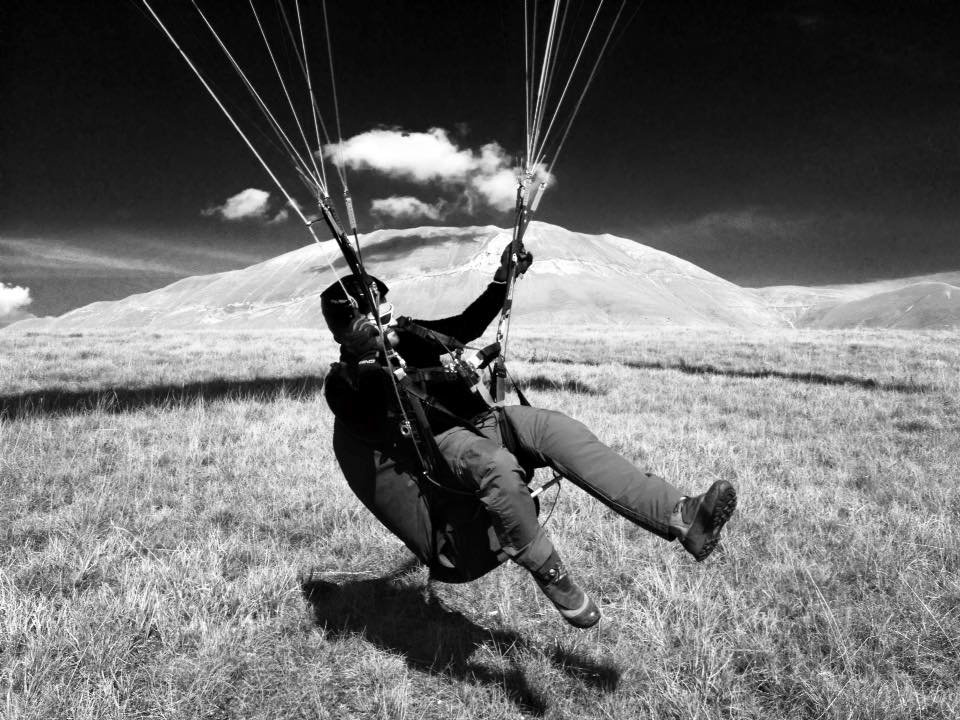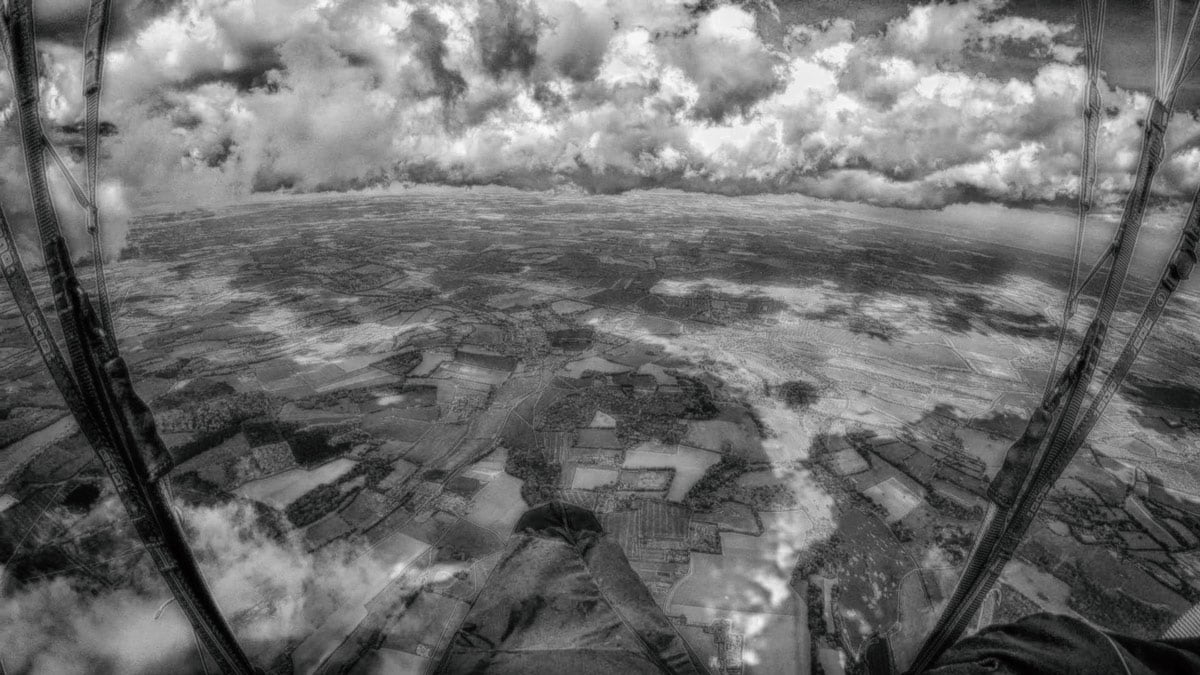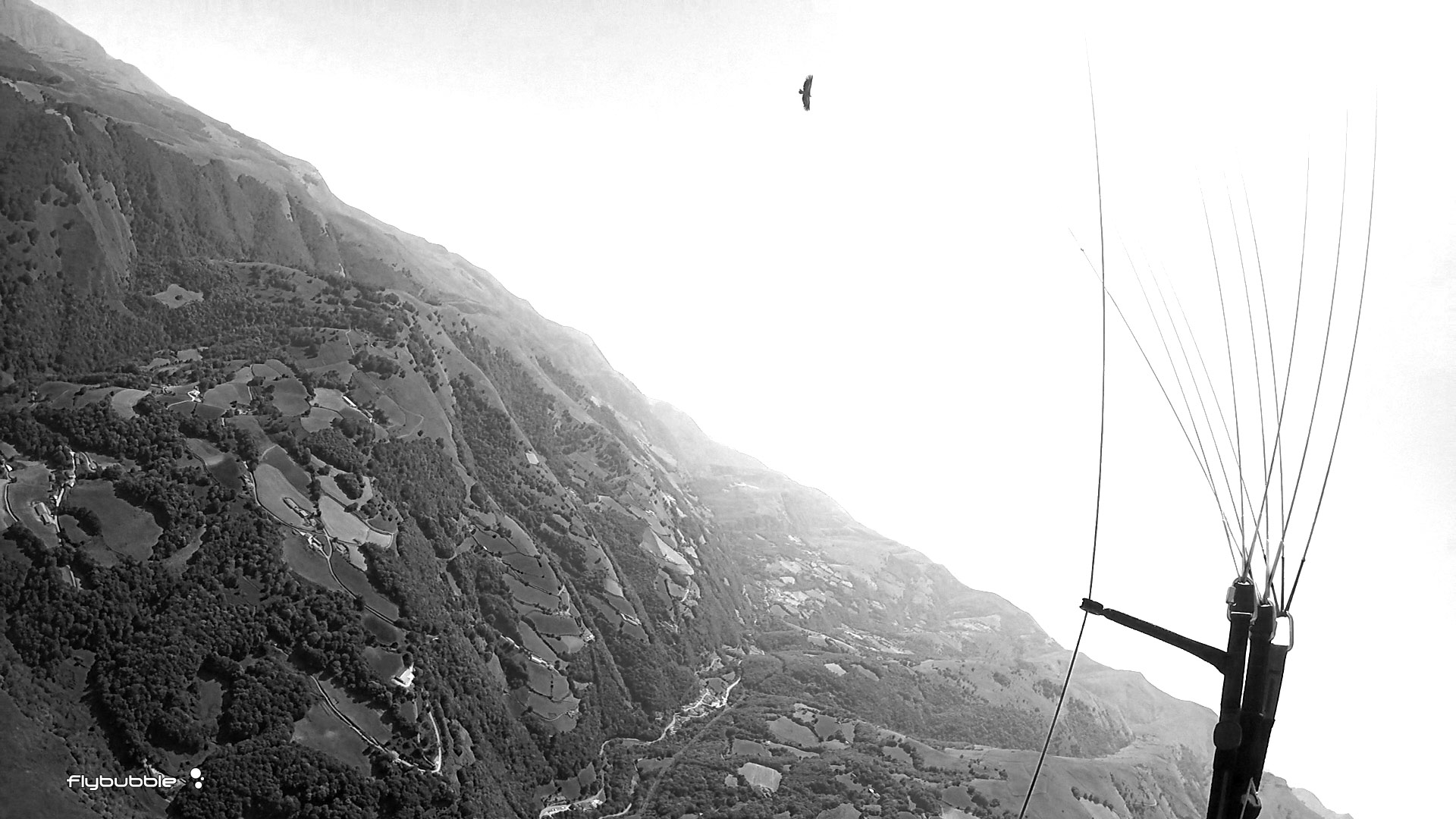
Photo by Rita Vogel Virgilio
We fly for many reasons.
We follow an urge to leave the earth and soar upwards, conquering gravity and the constraints of our physical form, transforming our grounded, 2-dimensional experience of space into the 3D playground of the sky. Joining the birds for a while unlocks endless panoramas of our beautiful planet.
When I began flying, it amazed me how relevant the sky had suddenly become. I felt the atmosphere over my head to become ‘my’ realm, whereas before it was but a distant backdrop above the horizon. Through flying, the air becomes our medium in the same way scuba diving brings us into a closer relationship to water.
Free flight is sublime. It takes us far beyond the normal range of human experience, alternately lifting us up to extreme heights of awareness and emotion, or drawing us down to experience our shadows.

Adrenaline and peace
Within duality there is always a paradox in everything we do, a yin/yang embedding of opposites.
Think of a racetrack – the faster the car needs to go, the more time is invested into its preparation. A Formula One team will expend months-worth of man-hours, just to shave 1/10 of one second from a lap time.
When riding a fast motorcycle, the feeling of invincibility brought on by the superhuman speed and power of the machine is inversely matched by the fragility of the human body, no amount of leather can take that life-threatening danger out of the equation.
Flying paragliders or hang gliders is also beyond intense. We too trade superhuman powers for a gamblers ticket, one we hope will never come in and see us following in Icarus’ footsteps.
In free-flight, dependent as we are on the fickle thermic lift, we play chicken with the flight envelope in gulleys and over low hot ground sources. We seek them out, desperately needing their catapulting effects, but afraid also of their power to collapse our fragile craft and send us crashing back into an unforgiving terrain.
We long for the powerful updraft of a towering cumulus. We find it, then dance in the capricious current, trembling in the knowledge of its casual power. We worship, as at an altar, marvelling at its majesty; when drawn too close we scurry away, humbled.
Looking down upon the earth, we feel as a king compared to the ants below us. Looking back up, we once again feel as significant as a fruit fly in a cathedral.

Sharing the Experience
When I return to the ground and am asked by non-flying friends how it was, I can never find a way to convey more than a tiny fraction of it; I open my mouth but am lost for words to describe the awesome beauty of climbing to 6,000 feet in a big sky, or of seeing the world spread out below while still being dwarfed by clouds the size of mountains.
How can I convey the extreme loneliness of being pulled into the disorientating whiteout of a big cumulus cloud, or the connection of a moment shared when a fellow pilot hooks into ‘my’ thermal after a 100km’s of hard-won travel, or the sweet pleasure of a kind, hitcher-friendly driver rescuing me far from home?
I cannot explain the challenge of simply getting away from the hill some days, the expedition required just to be on the right hill in the first place, the elation and fear I experience when finally piloting my gossamer hammock high in the sky.
It is also difficult for me to share the newfound appreciation I experience for the ‘normal’ world when I’m on two feet again. How can I convey the pleasure I feel resting beside a woodlands stream or squinting to see the detail of a tiny Forget-Me-Not, the joy of communing once again with Mother Earth’s beauty up close?
How can I share the satisfaction and exhaustion of a long cross country flight?

Achievement
The seeking to achieve and become good at the sport is also a huge motivation for many pilots to fly farther and farther by performing longer and longer flights.
The other week, I flew a sweetly rewarding 120km flight in 6 hours. The next day, I chased a bigger one, but in doing so wasted 7 hours driving, thereby missing out on what otherwise would have been a shorter but equally enjoyable flight exploring the beautiful Brecon Beacons.
These highs and lows are business as usual in our sport. The line between success and failure is razor thin. One minor decision, a hundred feet more gained in lift, a few degrees here or there on glide, arriving to the same point a minute earlier or a minute later, often makes the difference between decking it early and spending the afternoon looking upwards in frustration at a perfect paragliding sky, or continuing to a new personal best.
The more I rush, the more likely I am to make a mistake. When going cross country, the moment a flight starts to unravel can usually be traced to a moment of impatience or fear; the moment of leaving a zero or cloud base without clear intuition of where to find the next lift is often the error that swiftly sends me back to the ground. Then instead of flying far above the heads of those pitied bipeds below, I join them, only now burdened by the weight of a grounded aircraft, sweating in clothes chosen for a far higher altitude.
The ultimate goal for some pilots is vol-biv: an opportunity to leave the world behind and become as a bird for weeks or more at a time. Yet in this endeavour, the emotional stakes become even higher, the weather may not play ball and instead of achieving transcendent flight we may never once leave the ground, instead grinding our way over mountains on foot, stuck even deeper in shadow and frustration than if we’d never thought to try and fly that terrain in the first place.

Extreme sport
Flying stretches us. In the same flight we can experience the extremes of ‘combat flying’ in one moment, hanging onto a tight thermal simply to avoid the collapse waiting to happen if we drop out of the lift, while only a short while later finding ourselves spending a patient hour waiting out a zero for the terrain beneath or the sky around us to change and the air to begin working once more. The emotions I experience in one flight can vary from fear close to terror as the canopy collapses and the ground starts to rush up, to a beauty so sublime it brings tears to my eyes.
The calls are so marginal; which hill will work, what air mass is more conducive to staying up, which line will give me the best chance to navigate around airspace, is it worth taking the day off work at all or saving my leisure time for a better day?
We can, and do, drive ourselves nuts making decisions. A couple of years ago, after years of effort, the skills I’d invested so much time and energy to acquire began to bring me little joy. When I would experience pleasure from accomplishing a goal, I moved the bar higher, and felt the same longing and frustration, chasing a newer harder target.
Bombing out, or worse yet, getting stuck on the hill for half a day without leaving it at all, used to evoke in me emotions of anger and frustration intense enough to ruin more than the rest of my day – I’d feel pissed about it until the next opportunity to fly would present itself and I could ‘redeem myself’ by doing better.
I know I’m not alone in this, and we all know other pilots stuck in the same trap, I often see the fear of disappointment is a greater motivation than the hope of an enjoyable flight.
The solution to all this frustration, complexity, challenge and danger?

Surrender
In the air, I practice surrendering, tuning in to my breathing, to bring down my pulse rate, calm my head and drop my awareness into my heart.
Then I lay back in the harness, look up at my wing and ask: ‘Where do you want to go?’
The question helps me listen. Maybe this conversation only helps me to feel the pull of a distant updraft on the wing. Or perhaps it leads me to being better able to hear the whispering of my higher self, telling me in the intuitive language of the heart: bear right, no, not there, yes, yes, over there, there, is where the lift is…
Paradoxically, surrendering in the moment, into awe and joy at the luck that brings us such experience, returns to us the best chance both of continuing our flight, and, our very lives.
Each journey from A-B is like a sand mandala, a work of great beauty to be experienced, seen, enjoyed and then wiped away, leaving little trace but fading memory to commemorate the event. Ultimately, our flying is like our life, a beautiful odyssey of self-discovery with only the experience to show for it.
Through flying we gain membership to an exclusive club. Meeting the eyes of another free-flyer, we both know we have been ‘there’ and returned richer for the experience, changed by it in ways we can’t fully grasp, but in ways we know are invaluable.
Flying demands a clear head and humble approach. That oh-so-precious time in the air demands our fullest attention and brings us into the present. The banal, the humdrum, the pressure, the ridiculousness of modern life, can drop away and leave our minds clear and focused on the task at hand. This is one of the richest gifts; more than sufficient reward for our efforts. Being grateful for every moment in which we join the birds in flight is the only sane response to our mad pursuit.
